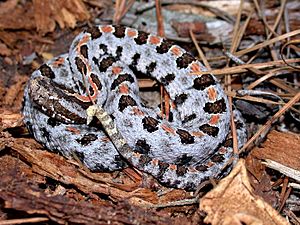Sistrurus facts for kids
Quick facts for kids Sistrurus |
|
|---|---|
 |
|
| A pygmy rattlesnake, S. miliarius. | |
| Scientific classification |
|
| Kingdom: | Animalia |
| Phylum: | Chordata |
| Class: | Reptilia |
| Order: | Squamata |
| Suborder: | Serpentes |
| Family: | Viperidae |
| Genus: | Sistrurus Garman, 1884 |
 |
|
| Synonyms | |
Sistrurus is a group of venomous pit vipers. They are often called ground rattlesnakes, pygmy rattlesnakes, or massasaugas. These snakes are found in Canada, the United States, and Mexico. The name Sistrurus comes from a Greek word meaning "tail rattler." This is similar to the ancient Egyptian musical instrument called a sistrum, which is a type of rattle. There are currently three known species in this group.
Contents
What Makes Sistrurus Snakes Special?
Sistrurus snakes are different from the larger Crotalus rattlesnakes in a few ways.
Size and Head Scales
They are generally smaller in size. Also, the scales on their heads are different. Sistrurus snakes have nine large plates on their heads. This is similar to another snake group called Agkistrodon. Most other vipers, including Crotalus, have many smaller scales covering their heads instead.
Their Unique Rattle Sound
Sistrurus snakes have a smaller rattle compared to Crotalus rattlesnakes. Because their rattle is smaller, it makes a higher-pitched, buzzing sound. It is not as loud or deep as the sound from a larger rattle.
Where Do Sistrurus Snakes Live?
Species of Sistrurus snakes live in various parts of North America. You can find them in Canada, especially in southeastern Ontario. They also live across the western, southern, and mid-western United States. There are also some groups of these snakes in southern and eastern Mexico.
Understanding Sistrurus Venom
All snake bites should be taken seriously. Bites from Sistrurus snakes are usually considered less dangerous to humans than bites from larger Crotalus rattlesnakes. This is mainly because Sistrurus snakes produce less venom. However, it is very important to get medical help right away if someone is bitten by any venomous snake.
Types of Sistrurus Snakes
Here are the currently recognized species of Sistrurus snakes:
| Image | Species Name | Common Name | Where They Live |
|---|---|---|---|
 |
S. catenatus | massasauga | North America, from southeastern Ontario (Canada) and western New York southwest to southeastern Arizona (USA) and northern Tamaulipas (Mexico). They live in places like swamps, marshes, and grasslands. |
 |
S. miliarius | pygmy rattlesnake | The Southeastern United States, from eastern and southern North Carolina south through Florida and west to Oklahoma and East Texas. They are found in flatwoods, sandhills, forests, floodplains, and near marshes and lakes. |
- Sistrurus at the Reptarium.cz Reptile Database. Accessed 5 December 2007.
See also
 In Spanish: Sistrurus para niños
In Spanish: Sistrurus para niños

